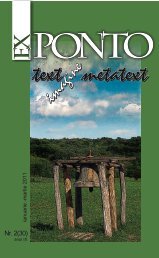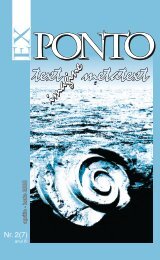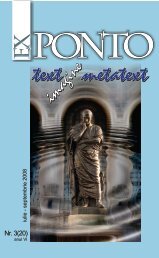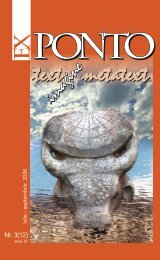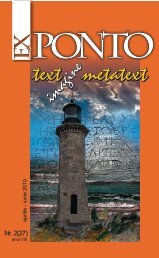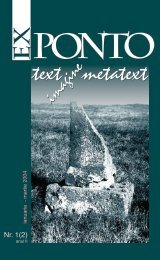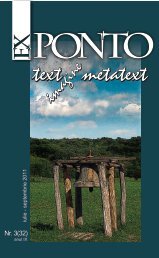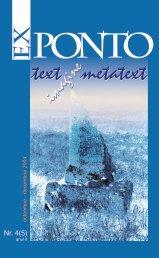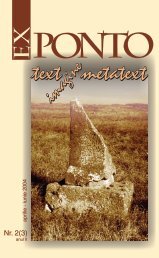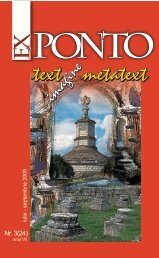Nr. 3 (28) anul VIII / iulie-septembrie 2010 - ROMDIDAC
Nr. 3 (28) anul VIII / iulie-septembrie 2010 - ROMDIDAC
Nr. 3 (28) anul VIII / iulie-septembrie 2010 - ROMDIDAC
You also want an ePaper? Increase the reach of your titles
YUMPU automatically turns print PDFs into web optimized ePapers that Google loves.
e grasped but, rather, a void, an impossible limit beyond which our Imaginary<br />
and Symbolic constructions of reality fail to go. 4 This void is what is most often<br />
left at the end of Murakami’s novels. The moment of illumination, that moment<br />
when the promise of the Real is eventually revealed to be nothing but a “wild<br />
sheep chase”, coincides with a waning process of memory and a persistent<br />
feeling of vacuum.<br />
After Shimamoto’s physical self disappears, the evidence of her existence<br />
also vanishes. Over the years, Hajime had kept in a drawer an envelope with<br />
the money he had received from an unknown man for not pursuing Shimamoto<br />
again. The disappearance of the envelope raises questions in Hajime’s mind<br />
as to whether Shimamoto was real or not. This is a crucial point in his search<br />
for the Real; it marks his understanding of the way memory works and his<br />
realization of the illusory nature of existence. Memory, he says, is just like<br />
a chain built out of several links; each link needs another link to uphold the<br />
reality of its existence; in order to support our impression of reality, we need<br />
to have this chain in its complete form, because, if one link breaks down, our<br />
whole perception of reality is turned upside down:<br />
Because memory and sensations are so uncertain, so biased, we always rely<br />
on a certain reality-call it an alternate reality-to prove the reality of events. To what<br />
extent facts we recognize as such really are as they seem, and to what extent<br />
these are facts merely because we label them as such, is an impossible distinction<br />
to draw. Therefore, in order to pin down reality as reality, we need another reality<br />
to relativize the first. Yet that other reality requires a third reality to serve as its<br />
grounding. An endless chain is created within our consciousness, and it is the<br />
very maintenance of this chain that produces the sensation that we are actually<br />
here, that we ourselves exist. (SBWS: 176)<br />
As a result of Shimamoto’s wavering ontological status, and probably also<br />
due to an attempt at emotional exorcism and forgetfulness, Hajime eventually<br />
asks the pianist in his jazz bar to stop singing the song which he played when<br />
he and Shimamoto used to meet. As if he were a character from Casablanca,<br />
he puts an end to Shimamoto’s memory and to the dear value this song held<br />
for so long. Suddenly, the song doesn’t impress him as before, it is no longer<br />
marked by that special affection needed to perceive it by the memory as a<br />
“Madeleine”.<br />
It is always the extraordinary, the special, the peculiar that Hajime looks<br />
for. Music reactivates pleasant memories only when the mind can associate<br />
it with individual experience. Liszt’s concertos have little value even when<br />
played by virtuosi with excellent technique. The performance does not reach<br />
to his soul, or as, he describes it, it throws a curtain between him and the<br />
pianist. Being used to listening to Liszt concertos on a scratched disk, Hajime<br />
misses that particular scratching sound which marks the intimacy between him<br />
and Shimamoto. It is not so much Liszt, as that anomaly contained solely by<br />
Shimamoto’s disks that lures Hajime into the impression that it is the only Liszt<br />
interpretation that can elicit emotions from him. Liszt’s music on that particular<br />
disk is thus rendered unique by the simple fact that it brings together two people<br />
and it opens an avenue towards the sentimental recesses of memory.<br />
By the same token, The Wind-Up Bird Chronicle delves deep into the<br />
burrows of the mind through the association between Rossini’s opera La Gazza<br />
Ladra (The Thieving Magpie) and the elusive bird that never allows itself to<br />
be seen, but whose song, resembling the sound made by a wound spring,<br />
Ex Ponto nr.3, <strong>2010</strong><br />
169




